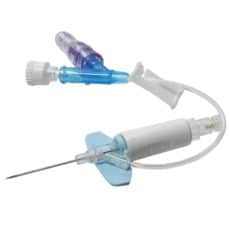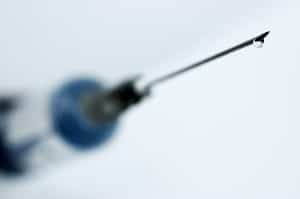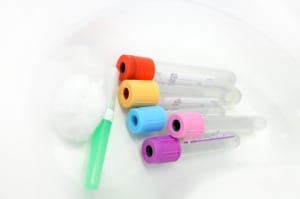Article introduces DeltaVen closed-system peripheral IV cannula

This article introduces the Smiths Medical DeltaVen closed-system peripheral IV cannula and includes three case studies describing its use in clinical practice and associated patient outcomes” Barton (2018). Abstract: Peripheral intravenous (IV) cannulas are the quickest and most effective way of gaining venous vascular access and administering IV therapy. Closed-system peripheral IV cannulas have been […]
Vessel Health and Preservation pathway for using vascular access devices

The Vessel Health and Preservation (VHP) model is a framework and pathway process, consisting of four quadrants, to guide initiation and management of treatment requiring intravenous access” Moureau and Carr (2018). Abstract: Use of intravenous devices for the delivery of medical treatment spans all healthcare facilities ranging from hospitals to clinics and home care. Clinical […]
Flushing interval for totally implantable venous access devices

The study aimed to describe the effects of prolonged FIs in a cohort of 317 patients with cancer. The authors found no significant difference in terms of TIVAD problems between long (>45 days) and short (≤45 days) FI groups, which raises questions over the validity of current practice” Rasero et al (2018). Abstract: Totally implantable […]
Assessment and maintenance of peripheral IV catheters

Improving the safety and quality of health care relies on implementing evidence-based findings into every-day clinical practice” Ray-Barruel and Rickard (2018). Abstract: Improving the safety and quality of health care relies on implementing evidence-based findings into every-day clinical practice. Numerous clinical decision aids have been developed to guide nursing care of the patient with a […]
Risks of intravenous therapy and know how to reduce them

…reflects on the potential problems that can occur with the administration of intravenous therapy” Brooks (2018). Abstract: Nicola Brooks, Associate Dean, Faculty of Health and Life Sciences, De Montfort University, reflects on the potential problems that can occur with the administration of intravenous therapy. Reference: Brooks, N. (2018) Remember the risks of intravenous therapy and […]
OPAT outcomes for patients who are known to inject drugs?

Patients with current IDU on OPAT did not have less favorable treatment outcomes compared to those without current IDU” Vazirian et al (2018). Abstract: BACKGROUND: Historically, there has been a restrictive approach toward outpatient parenteral antimicrobial therapy (OPAT) in patients with injection drug use (IDU) due to the fear that they might utilize the intravenous […]
PICC-related thrombosis associated with ABO blood group
Our pilot study aimed to examine whether PICC-related thrombosis is influenced by ABO blood group” Haddad et al (2018). Abstract: Peripherally inserted central catheter (PICC) use is associated with many complications including line-related thrombosis. Several studies and meta-analyses confirmed the increased risk to develop venous thromboembolism in non-O blood group individuals. Our pilot study aimed […]
Peripheral vein cannulation and restraint performed on preschool-aged children
The purpose of this study was to provide a better understanding of how parents experience the use of restraint during the performance of peripheral vein cannulation (PVC) on their child” Svendsen et al (2018). Abstract: Purpose: The purpose of this study was to provide a better understanding of how parents experience the use of restraint […]
Misplaced PICC presenting as contralateral pleural effusion

The baby developed respiratory distress with persistent hypoxia after TPN was initiated through the PICC line” Kumar et al (2018). Abstract: A preterm neonate born at 27 weeks, with a birth weight of 555 g, was on continuous positive airway pressure (CPAP) for apnoea of prematurity and initially received total parenteral nutrition (TPN) through the […]
Malformation of right internal jugular vein results in failed catheter placement
We herein present a case of failure to place a tunneled hemodialysis catheter into the right IJV” Zhu et al (2018). Abstract: The right internal jugular vein (IJV) is an important access site for hemodialysis catheterization. Venous cannulation failure is usually caused by central venous stenosis and is rarely related to vessel malformation. We herein […]
In-line filtration reduces postoperative peripheral IV catheter phlebitis

The aim of this study is to demonstrate the efficacy of in-line filtration in reducing the incidence of postoperative phlebitis associated with peripheral short-term vascular access” Villa et al (2018). Abstract: BACKGROUND: Peripheral venous cannulation is an everyday practice of care for patients undergoing anesthesia and surgery. Particles infused with intravenous fluids (eg, plastic/glass/drugs particulate) […]
Endovascular removal of venous catheter embolization

Percutaneous intervention for removal of intravascular foreign bodies is currently the best treatment option for patients” Rodrigues et al (2017). Abstract: INTRODUCTION: Intravascular or catheter embolization of a foreign body, either by fracture or migration, is a rare condition, occurring in approximately 1%. This study is focused on the migration of catheters since they represent […]
Complications of different types of PICC through femoral vein catheterization

Single-lumen power-injectable peripherally inserted central catheters with no valve had a high gravity flow rate, were strong and not prone to rupture, tolerant to high-pressure injection, and were more suitable for femorally inserted central venous catheterization in patients with lung cancer undergoing chemotherapy” Xu et al (2018). Abstract: PURPOSE: This study aimed to investigate the […]
Superior vena cava syndrome due to central port catheter thrombosis
Herein, we present a rare case of a 69-year-old woman, with a history of hepatic flexure tumor and an indwelling central venous port, presenting with acute signs and symptoms of SVCS due to thrombosis of the catheter” Lianos et al (2018). Abstract: Superior vena cava syndrome (SVCS) represents undoubtedly a rare life-threatening condition. Herein, we […]
Central venous jugular catheters in critically ill dogs and cats

To describe problems noted during central venous jugular catheter (CVJC) placement, conditions associated with unsuccessful catheterization, and CVJC maintenance complications” et al (2018). Abstract: OBJECTIVE: To describe problems noted during central venous jugular catheter (CVJC) placement, conditions associated with unsuccessful catheterization, and CVJC maintenance complications. DESIGN: Prospective observational study from September 2014 to September 2015. […]
Equation to determine length of peripherally inserted central catheter

The aim of this study was to develop a formula guiding the peripherally inserted central catheter (PICC) tip placement based on anatomical landmarks such as the upper arm, clavicle, and sternum as well as the patient’s height, weight, and body mass index” Kang et al (2018). Abstract: BACKGROUND: The aim of this study was to […]
PICC associated extravasation of total parenteral nutrition

In this report, we describe a case of PICC inserted from an upper extremity with migration into the inferior vena cava (IVC) and the hepatic vein associated with extravasation of the total parenteral nutrition (TPN) into the peritoneum and the liver” Gupta et al (2018). Abstract: Peripherally inserted central catheters (PICC) are the mainstay of […]
Central and peripheral D-dimer sample sites are not equivalent

To evaluate the usefulness of a negative D-dimer in peripheral or central venous blood to screen for asymptomatic catheter-related thrombosis in cancer patients” Nañez-Terreros et al (2018). Abstract: Objectives: To evaluate the usefulness of a negative D-dimer in peripheral or central venous blood to screen for asymptomatic catheter-related thrombosis in cancer patients. Methods: D-dimer was […]
Leadless pacemaker placement to preserve central veins

We report a case of successful placement of a leadless pacemaker in a dialysis patient to preserve the central veins for future vascular access creation” Maradey et al (2018). Abstract: Cardiac rhythm disorder is frequently encountered in hemodialysis patients and is often treated with a cardiovascular implantable electronic device (CIED). The conventional CIED requires placement […]
Consequences of intravenous drug incompatibilities in critically ill patients

The aim of this review is to analyse the clinical consequences of intravenous drug incompatibilities in critically ill patients, especially the incidence of organ dysfunctions and mortality” Benlabed et al (2018). Abstract: OBJECTIVE: The aim of this review is to analyse the clinical consequences of intravenous drug incompatibilities in critically ill patients, especially the incidence […]
Outcome of ED visits during outpatient parenteral antimicrobial therapy treatment

This study’s purpose was to identify risk factors for ED visits during OPAT and risk factors for hospitalization among patients with ED visits” Shrestha et al (2018). Abstract: OBJECTIVES: Patients receiving outpatient parenteral antimicrobial therapy (OPAT) may require emergency department (ED) visits to manage complications. This study’s purpose was to identify risk factors for ED […]
Standardized susceptibility testing for microbial biofilms in clinical practice

Treatment of biofilm-related infections is difficult, as sessile microorganisms show reduced antimicrobial susceptibility as a result of various resistance and tolerance mechanisms” Coenye et al (2018). Abstract: Biofilms are communities of microbial cells that are attached to each other and/or a surface, and are embedded in an extracellular matrix produced by the bacteria and/or derived […]
The brachiocephalic vein as an alternative to internal jugular vein cannulation
Brachiocephalic cannulation is a reasonable alternative to ultrasound-guided internal jugular vein catheterization” Beccaria et al (2018). Abstract: BACKGROUND: Although many studies have compared success and complication rates for central line insertion sites with and without ultrasound, few have examined the use of the brachiocephalic vein for central venous access. The aim of this study was […]
Disinfection of contaminated gloved hands reduces bacterial transmission of needleless valves

Since there is no data demonstrating that such practice attributes to lower bacterial transfer during clinical care, a standardised experimental study was conducted” Assadian et al (2018). Summary: Disinfection of gloved hands is increasingly advocated in situations where visibly not soiled gloves are used during multiple clinical activities on the same patient. Since there is […]
Delayed catheter removal for patients with central-venous-catheter-related Gram-negative bacteraemia

This study evaluated the impact of delayed central venous catheter (CVC) removal on clinical outcomes in patients with Gram-negative CRBSI” Lee et al (2018). Summary: Background: Gram-negative bacteria are increasingly the cause of catheter-related bloodstream infection (CRBSI), and the prevalence of multi-drug-resistant strains is rising rapidly. This study evaluated the impact of delayed central venous […]
Chlorhexidine-coated PICC reduce fibroblastic sleeve formation

Among the three anti-thrombogenic peripherally inserted central catheter technologies, the chlorhexidine-peripherally inserted central catheter had the smallest fibroblastic sleeves…” Sylvia et al (2018). Abstract PURPOSE: This study compared an antimicrobial and anti-thrombogenic peripherally inserted central catheter treated with a chlorhexidine-based technology, a peripherally inserted central catheter with bulk distributed fluoro-oligomers, and a poly 2-methoxyethyl acrylate-based […]
Order of phlebotomy draw and impact on clinical biochemistry results

The order of draw of venous sampling is suspected to affect analytical results, in particular for coagulation analysis. Here we compare the procedures in venous blood sampling among clinical biochemistry departments to assess the uniformity of order of blood draw and adherence to international guidelines in the Danish health care system” Jacobsen et al (2018). […]
Management of right auricular thrombus related to central venous catheter

We report the case of a 38-year-old man, who developed an asymptomatic catheter-inducible right atrial thrombi requiring open heart surgery, after taking a central venous catheter for thirty-five days” Ribeiro et al (2018). Abstract: Central venous catheters are widely used in critically ill patients; however, they are also associated with increased morbidity and mortality. The […]
Bloodstream infection surveillance in Polish intensive care units

The aim of the study was to analyze the epidemiology, microbiology and antibiotic therapy of nosocomial BSI in Polish ICU patients” Wałaszek et al (2018). Abstract: INTRODUCTION: Nosocomial bloodstream infections (BSI) among patients in intensive care units (ICU) are the most common form of nosocomial infections and they are serious complications of the treatment process. […]
CLABSI rates among children with immune compromised conditions
This article describes changes in central line-associated bloodstream infection (CLABSI) rates among common causative organisms over an 11-year period on a pediatric inpatient unit prior to and following CLABSI reduction strategies” Linder et al (2018). Abstract: This article describes changes in central line-associated bloodstream infection (CLABSI) rates among common causative organisms over an 11-year period […]

